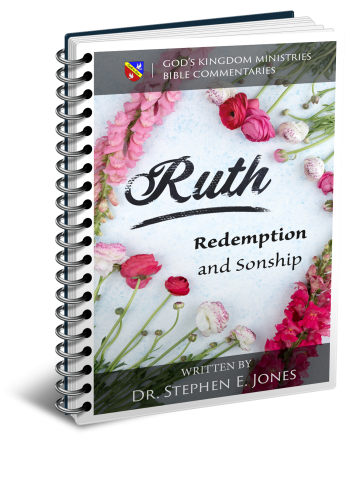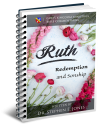Latest Posts
View the latest posts in an easy-to-read list format, with filtering options.

The book of Ruth is the Bible's primary illustration of the law of sonship found in Deuteronomy 25. The story also illustrates the principles of New Covenant marriage as God set forth from the beginning. In addition, it is a natural sequel to the last five chapters of the book of Judges, showing the moral contrast between the home towns of Saul and David as a way of explaining the failure of Saul and the success of David.
Category - Bible Commentaries

The law of sonship in Deuteronomy 25 is largely based on the more basic laws of inheritance. In the days of Ruth and Boaz, the land itself represented the promise of God, beginning with Abraham. When Jacob-Israel took the entire household to Egypt, they left the land of their inheritance. This set the stage for their bondage in Egypt and ultimately their redemption under Moses and their return under Joshua.
The Israelites left Egypt with the promise to inherit the land of Canaan. It took 40 years for them to enter the land in the next generation, but under Joshua the land was finally divided among the families and tribes in their first Sabbath year in Canaan (Joshua 14:1).
We know the timing of this, because Caleb said he was 40 years old when he helped spy out the land when Israel was camped at Kadesh-barnea (Joshua 14:7). It was 38 years from Kadesh-barnea to the year that Joshua led Israel across the Jordan (Deut. 2:14). So we know that Caleb was 78 when he crossed the Jordan with Joshua.
When Caleb was 85, he received his inheritance in the land of Canaan. In Joshua 14:10 Caleb said,
10 And now behold, the Lord has let me live, just as He spoke, these forty-five years from the time that the Lord spoke this word to Moses, when Israel walked in the wilderness; and now behold, I am eighty-five years old today.
So we see that the tribes and families received their inheritances in the first Sabbath year after their Jordan crossing.
Yet much of the land still remained in the hands of the Canaanites and Philistines, and they were unable to receive the full inheritance that had been promised to them (Joshua 13:1). Even as Joshua was unable to give them the true “rest” (Hebrews 4:8, 9), so also was he unable to secure their full inheritance. Why? Because overall, the nation was functioning under the Old Covenant, which, from the start, was doomed to failure, because it was based upon the will of man.
Nonetheless, there were overcomers throughout that entire period of time who understood that their salvation and inheritance was really based on the will of God and His promises. These were New Covenant believers in an overall Old Covenant era, men born out of season, as it were. They were the remnant of grace, which numbered 7,000 in the time of Elijah (1 Kings 19:18; Rom. 11:4, 5). For this remnant, the New Covenant was not totally forgotten, for they remembered that it had already been established with both Noah and Abraham, long before the Old Covenant under Moses.
The land of Canaan was Israel’s Old Covenant inheritance. While it is true that the land seemed to be the promise given to Abraham, the father of New Covenant faith, it was not the ultimate inheritance that God intended. So we read in Heb. 11:13-16,
13 All these died in faith, without receiving the promises, but having seen them and having welcomed them from a distance and having confessed that they were strangers and exiles on the earth. 14 For those who say such things make it clear that they are seeking a country of their own. 15 And indeed if they had been thinking of that country from which they went out [i.e., Canaan], they would have had opportunity to return. 16 But as it is, they desire a better country, that is a heavenly one. Therefore, God is not ashamed to be called their God, for He has prepared a city for them.
Long before Paul wrote these words, the Israelites had been exiled to Assyria and never returned, because God had prevented their return. God had divorced Israel and had sent her out of the house (Jer. 3:8) according to the law in Deut. 24:1, KJV. She had remarried false gods, and so it would have been unlawful for God to allow Israel back into His house (Deut. 24:2-4).
So the author of Hebrews tells us that Canaan (“that country from which they went out”) was not truly the country that Abraham sought. Abraham sought “a better country, that is, a heavenly one,” elsewhere called the New Jerusalem or the heavenly Jerusalem. This heavenly Jerusalem fit the description of Sarah, not Hagar (Gal. 4:23-26). Sarah was a type of the New Covenant and the heavenly Jerusalem. Hagar represented the Old Covenant and the earthly Jerusalem—and, by extension, the land of Canaan itself.
Those who believe the message of the book of Hebrews, wherein we are admonished to immigrate from the Old Covenant to the New, desire and seek this “better country,” which can be found only through Abraham’s New Covenant faith. Those who remain under the failed Old Covenant continue to desire the old land, now called Palestine and “Israel.”
At best, the land of Canaan was a type and shadow of greater things to come. It was a model, much like the earthly temple in Jerusalem, which was built according to the pattern of the heavenly temple that David saw by the eye of revelation. 1 Chron. 28:11, 12 says,
11 Then David gave to his son Solomon the plan [tabniyth, “pattern, plan, model”] of the porch of the temple, its buildings, its storehouses, its upper rooms, its inner rooms, and the room for the mercy seat; 12 and the plan [tabniyth] of all that he had in mind [ruwach, “by the spirit”] for the courts of the house of the Lord….
The KJV has a better translation, for there tabniyth is rendered “pattern,” and “all that he had in mind” (NASB) is rendered “all that he had by the Spirit.” In other words, by the Spirit, David saw or envisioned the temple in heaven, and he then created an earthly model of the heavenly reality. Moses did the same when he built the Tabernacle and the Ark of the Covenant (Exodus 25:9, 40; Numbers 8:4).
The land of Canaan, the earthly Jerusalem, and Solomon’s temple were all just Old Covenant models that were patterned after a heavenly reality. If they had been used correctly as models to teach heavenly things, there would have been no problem. But as long as men treated those models as if they were the reality that God had promised, they remained blinded by the veil of the Old Covenant (2 Cor. 3:14, 15).
We, however, are the children of promise, the Isaac company (Gal. 4:26, 28), and thus we are inheritors of the promises of God through the New Covenant. We are among those who have immigrated to a new way of life, based on better promises and a better covenant. We do not seek the land of Canaan for ourselves, nor do we encourage Jews to seek it for themselves as if it were the heavenly reality. Both Jews and non-Jews must receive the promise of God exclusively through the New Covenant and its one Mediator, Jesus Christ.
As I stated earlier, the Old Covenant model focused its attention on the land of Canaan. That was Israel’s inheritance at the time, and this land inheritance was the foundation of their way of life. To lack a physical heir was to lose one’s inheritance in the land. Hence, when Naomi’s husband and two sons died in Moab, her family estate would have been given to her nearest relative when she died with no heir.
This is why the law of sonship was legislated in Deuteronomy 25. It was to provide a legal means by which one’s inheritance could be retained in spite of disaster. As all of the other laws, this law proved to be as prophetic, for it revealed the manner in which Christ Himself could regain His inheritance in the earth. Christ died childless, and we are His younger brethren who are called to raise up seed to our elder Brother by this lawful provision.
But under the New Covenant, we have an inheritance that is much greater than owning a piece of land in Palestine. Our bodies are made of dust from the ground. Adam was named after the ground (adamah). He lost his inheritance through sin when he was sold to the earth in payment of debt. To lose one’s freedom is to become a slave to sin (Rom. 7:14), forced to follow sin’s command to violate the law.
The solution is found in “the last Adam” (1 Cor. 15:45), who has paid the price to redeem us, purchasing us as His bondservants (1 Cor. 6:20). Our new Master now commands us to obey the law of God, rather than to violate it (Rom. 7:25).
The feast days set forth the pattern for the restoration of our true inheritance that was lost in Adam. That inheritance is immortality, whereby we re-inherit our “land.” This is the New Covenant promise from the beginning of time. The Old Covenant land inheritance in Canaan was an earthly model designed to teach us the principles of the true inheritance.